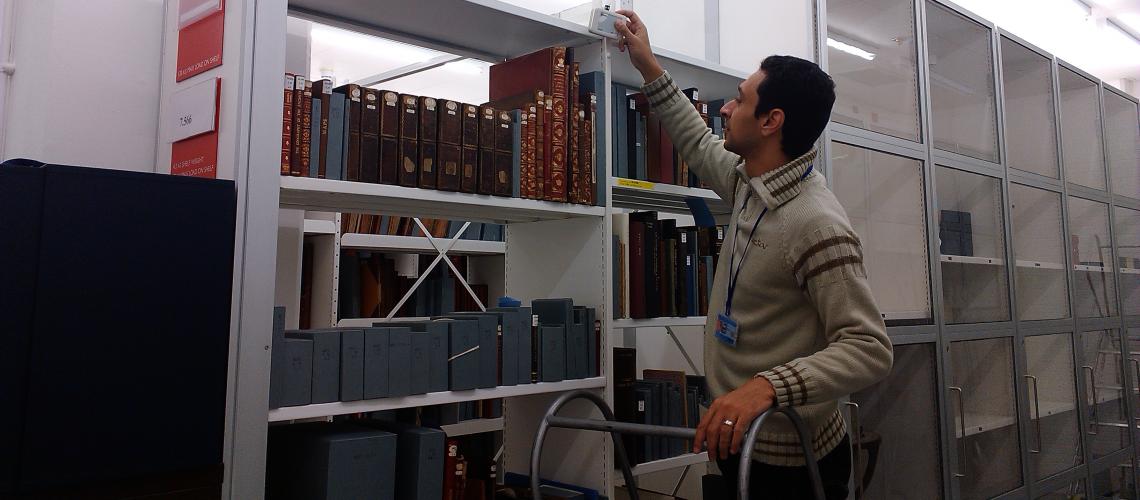Books are important cultural and historical records that need to be preserved for future generations. However, these materials are also susceptible to damage from a variety of factors, including environmental conditions, pests, and improper handling. Preventive conservation is the practice of taking steps to prevent damage to books. This can be done through a variety of methods, including:Controlling the environment:Books should be stored in a cool, dry environment with low levels of humidity and pollutants.The recommended temperature and humidity for book storage are:
- Temperature: 60-70 degrees Fahrenheit (16-21 degrees Celsius)
- Relative humidity: 40-50%
It is important to keep the temperature and humidity levels consistent, as fluctuations can damage the books. Avoid storing books in areas that are too hot, too cold, too dry, or too humid.Here are some tips for storing books in a cool, dry place:
- Store books in a room that is not too hot or too cold. The ideal temperature for book storage is between 60 and 70 degrees Fahrenheit (16-21 degrees Celsius).
- Keep the relative humidity level (RH) in the room at 40-50%. Too much humidity can cause mold to grow, while too little humidity can cause the pages to become brittle.
- Avoid storing books in direct sunlight or near heat sources. Sunlight can fade the pages and heat can cause the binding to deteriorate.
- Keep books away from dust and dirt. Dust can damage the pages and dirt can attract pests.
- If you have a lot of books, consider storing them in a bookcase or cabinet. This will help to protect them from dust and dirt.
- If you are storing books for a long period of time, consider using a desiccant pack to help control the humidity level.
Using proper storage materials:Books should be stored in acid-free containers and on acid-free paper to prevent them from deteriorating. Acidic paper contains chemicals that can cause the paper to become brittle and yellow over time. This can make the book difficult to read and can even damage the binding. Acid-free paper, on the other hand, is made from materials that do not contain acids. This helps to preserve the book's condition and makes it last longer.Here are some of the benefits of storing books in acid-free containers and on acid-free paper:
- Prevents paper from deteriorating. Acidic paper can cause the paper to become brittle and yellow over time. This can make the book difficult to read and can even damage the binding. Acid-free paper, on the other hand, is made from materials that do not contain acids. This helps to preserve the book's condition and makes it last longer.
- Prevents mold and mildew growth. Mold and mildew can grow on paper if it is stored in a humid environment. This can cause the paper to become discolored and damaged. Acid-free paper is less likely to attract mold and mildew, which helps to protect the book from these harmful fungi.
- Protects against pests. Pests, such as insects and rodents, can damage books if they are not properly stored. Acid-free paper is less likely to be eaten by pests, which helps to protect the book from these destructive creatures.
If you have valuable books that you want to preserve for future generations, it is important to store them in acid-free containers and on acid-free paper. This will help to ensure that your books last for many years to come.Here are some tips for choosing acid-free containers and paper:
- Look for products that are labeled as "acid-free" or "archival quality." These products are made from materials that will not damage your books.
- Avoid products that are made from wood pulp. Wood pulp is acidic, which can damage your books over time.
Providing proper handling instructions:Staff and visitors should be trained on how to properly handle books and bindings.Here are some tips on how to provide proper handling instructions for handling books:
- Start by explaining the importance of proper handling. Books are fragile objects and can be easily damaged if not handled properly. Explain to staff and visitors that by following a few simple guidelines, they can help to protect the books and ensure that they last for many years to come.
- Explain how to hold a book. When holding a book, staff and visitors should always support the spine with one hand and the covers with the other hand. This will help to prevent the book from bending or tearing.
- Explain how to open a book. When opening a book, staff and visitors should always open it gently and slowly. They should also avoid bending the pages too far back.
- Explain how to close a book. When closing a book, staff and visitors should always close it gently. They should also avoid pressing down on the spine too hard.
- Explain how to handle books with special bindings. Some books have special bindings, such as hardcovers or leather bindings. These bindings are more delicate than standard bindings and should be handled with care. Staff and visitors should be instructed to follow the manufacturer's instructions for handling these types of books.
- Provide examples of improper handling. It can be helpful to provide examples of improper handling so that staff and visitors can understand what to avoid. Some examples of improper handling include:
- Bending the spine of the book
- Tearing the pages
- Writing in the book
- Spilling liquids on the book
- Dropping the book
- Encourage staff and visitors to report any damaged books immediately. If a book is damaged, it is important to report it immediately so that it can be repaired or replaced.
- Provide regular refresher training. It is a good idea to provide regular refresher training on proper handling procedures. This will help to ensure that staff and visitors remember the importance of handling books with care.
Watch this video tutorial of the right way of Handling Bindings
Conducting regular condition assessments:Books should be regularly inspected for signs of damage because early detection and repair can help to prevent further damage and extend the life of the book. Here are some of the reasons why books should be regularly inspected:
- To identify damage. Early detection of damage is important because it can help to prevent further damage and extend the life of the book. If damage is not detected early, it can become worse and make it more difficult or impossible to repair.
- To determine the cause of damage. Once damage has been identified, it is important to determine the cause of the damage so that steps can be taken to prevent it from happening again. Some common causes of book damage include:
- Improper handling
- Environmental factors, such as humidity, temperature, and light
- Pests, such as insects and rodents
- Mold and mildew
- To assess the severity of damage. The severity of the damage will determine the type of repair that is needed. Some minor damages, such as a torn page, can be repaired by a trained professional. More severe damages, such as a water-damaged book, may need to be restored by a professional conservator.
- To develop a preservation plan. Once the severity of the damage has been assessed, a preservation plan can be developed. This plan will outline the steps that need to be taken to prevent further damage and preserve the book for future generations.
If you have a collection of books, it is important to develop a regular inspection schedule. This will help to ensure that your books are properly cared for and that any damage is detected early.Sherif Afifi - Conducting regular condition assessment - The British Library, LondonHere are some tips for conducting regular condition assessments:
- Inspect your books regularly. The frequency of your inspections will depend on the size and value of your collection. However, it is a good idea to inspect your books at least once a year.
- Use a checklist. A checklist can help you to ensure that you are inspecting all of the important aspects of your books. Some items to include on your checklist are:
- The condition of the binding
- The condition of the pages
- The presence of any damage
- The presence of any pests or mold
- Record your findings. It is important to record your findings so that you can track any changes in the condition of your books over time. This information can also be helpful if you ever need to file an insurance claim.
- Take action to repair or replace damaged books. If you find any damage, take action to repair or replace the book as soon as possible. This will help to prevent further damage and extend the life of the book.
In conclusion here are some additional tips for the preventive conservation of books:
- Avoid direct sunlight: Direct sunlight can cause fading and discoloration of paper and other materials.
- Avoid extreme temperatures: Extreme temperatures can cause the paper to become brittle and other materials to warp or crack.
- Keep materials away from moisture: Moisture can cause paper to become moldy and other materials to deteriorate.
- If books are infected with mold, use gloves when handling them: Gloves will help to protect your hands from dirt, molds, and other contaminants.
- Do not eat or drink near materials: Food and drink can attract pests and cause staining.
- Clean materials regularly: Dust and dirt can damage materials over time.
- Repair damage promptly: Minor damage can be repaired with simple methods, such as mending tears or reinforcing weak bindings.
- Consult a conservator for major damage: Major damage should be repaired by a professional conservator.
By following these tips, you can help to ensure that archival materials and books are preserved for future generations.Here are some resources for additional information on preventive conservation:The American Institute for Conservation:The American Institute for Conservation (AIC) is a professional organization for conservators. The AIC website has a wealth of information on preventive conservation, including articles, webinars, and online courses.The National Archives and Records Administration (NARA):NARA is the official archive of the United States government. NARA has several resources on preventive conservation, including fact sheets, training materials, and a blog.The Society of American Archivists (SAA):The Society of American Archivists (SAA) is a professional organization for archivists. The SAA website has several resources on preventive conservation, including articles, webinars, and online courses./////////////////////////////////////////////////////////Sherif AfifiCreating a Knowledge Sharing Culture/////////////////////////////////////////////////////////-------------------My Facebook page:https://www.facebook.com/sherif3afifiPlease subscribe to my YouTube channel here: https://www.youtube.com/sherif3afifi



